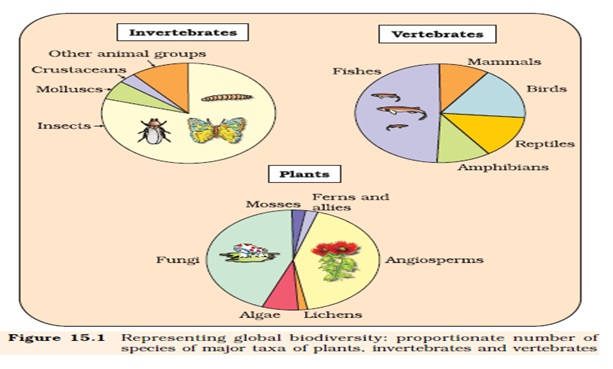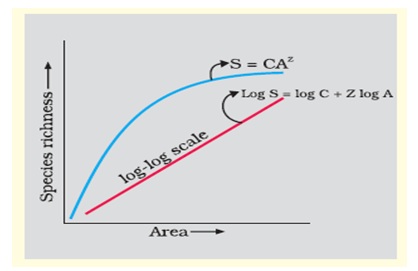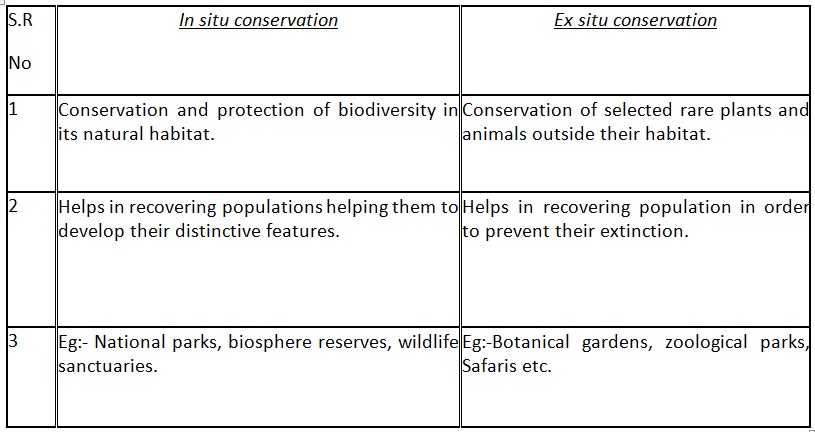CHAPTER 15 – BIODIVERSITY & CONSERVATION
• Definition- Biodiversity can be defined as the totality of genes, species and ecosystems of a given region.
• This term was coined by EDWARD WILSON
• Diversity ranges from macromolecules to biomes.
• Biodiversity can be studied at-
1. Genetic diversity
2. Species diversity
3. Ecological/Ecosystem diversity
1. GENETIC DIVERSITY
• Greater the genetic diversity among organisms of a species, more sustenance it has against environmental perturbations.
• Genetically uniform populations are highly prone to disease harsh environment.
• Rauwolfia vomitoria shows genetic variation in terms of concentration and potency of chemical reserpine
• There are more than 50,000 varieties of rice and nearly 1000 varieties of mangoes.
2. SPECIES DIVERSITY
Important measures-
1. Species richness: It refers to the number of species per unit area.
2. Species Evenness: It refers to the relative abundance with which each species is represented in an area.
• The variety and number of individuals determine the level of diversity of an ecosystem.
• The Western Ghats have a greater diversity of amphibian species than the Eastern Ghats.
3. ECOLOGICAL DIVERSITY
• Ecological Diversity is related to species diversity.
• India has greater ecosystem diversity than any other Scandinavian country.
• India has several biomes like alpine meadows, rain forests, deserts, wetlands, mangroves…etc..
GLOBAL BIODIVERSITY
• This term was coined by EDWARD WILSON
• Diversity ranges from macromolecules to biomes.
• Biodiversity can be studied at-
1. Genetic diversity
2. Species diversity
3. Ecological/Ecosystem diversity
1. GENETIC DIVERSITY
• Greater the genetic diversity among organisms of a species, more sustenance it has against environmental perturbations.
• Genetically uniform populations are highly prone to disease harsh environment.
• Rauwolfia vomitoria shows genetic variation in terms of concentration and potency of chemical reserpine
• There are more than 50,000 varieties of rice and nearly 1000 varieties of mangoes.
2. SPECIES DIVERSITY
Important measures-
1. Species richness: It refers to the number of species per unit area.
2. Species Evenness: It refers to the relative abundance with which each species is represented in an area.
• The variety and number of individuals determine the level of diversity of an ecosystem.
• The Western Ghats have a greater diversity of amphibian species than the Eastern Ghats.
3. ECOLOGICAL DIVERSITY
• Ecological Diversity is related to species diversity.
• India has greater ecosystem diversity than any other Scandinavian country.
• India has several biomes like alpine meadows, rain forests, deserts, wetlands, mangroves…etc..
GLOBAL BIODIVERSITY
- According to the IUCN(2004) the total number of plant and animal species is about 1.5 million.
- More than 70% of the species recorded are animals and plants account for about 22%; 70% of the animals are insects.
- A more conservative and scientifically sound estimate has been made by Robert May ; it puts the global species diversity at about seven million.
These estimates do not give any figure for prokaryotes for the following reasons:
1.The conventional taxonomic methods are not sufficient for identifying these microbial species
2. Many of these species cannot be cultured under laboratory conditions.
3. Biochemical and molecular biology techniques would put their diversity into millions.
BIODIVERSITY IN INDIA
• India is one of the twelve mega biodiversity countries of the world.
• India has only 2.4% of the land area of the world, it has 8.1% of the global species biodiversity.
• There are about 45,000 species of plants and about 90,000-1,00,000 species of animals.
• New species are yet to be discovered and named.
• Applying Robert May’s global estimate, only 22% of the total species have been recorded, India has probably more than 1,00,000 species of plants and 3,00,000 species of animals to be discovered and described.
PATTERNS OF BIODIVERSITY
• Biodiversity is not uniform throughout the world but varies with latitude and altitude.
• Favourable environmental conditions favour speciation and make it possible for a larger number of species to exist there , i.e., biodiversity is more in such areas than the others.
1.Latitudinal Gradients
VARIATION OF SPECIES WITH LATITUDE
• The number of species of vascular plants in tropics is about ten times more than that of temperate forests.
• Amazonian Rainforest has the greatest biodiversity on earth. It has more than 40000 species of plants, 1,25,000 species of insects, 300 species of fish, 427 of amphibian and 378 of reptiles, 1300 species of birds and 427 of mammals.
2.Species-Area Relationship
• Alexander Von Humboldt has observed that within a region, species richness gets increased when explored area is increased, but only up to a limit.
• The relationship between species richness and area for a number of taxa like angiospermic plants, fresh water fishes and birds is found to be a rectangular hyperbola.
Graph showing Species-Area Relationship
1.The conventional taxonomic methods are not sufficient for identifying these microbial species
2. Many of these species cannot be cultured under laboratory conditions.
3. Biochemical and molecular biology techniques would put their diversity into millions.
BIODIVERSITY IN INDIA
• India is one of the twelve mega biodiversity countries of the world.
• India has only 2.4% of the land area of the world, it has 8.1% of the global species biodiversity.
• There are about 45,000 species of plants and about 90,000-1,00,000 species of animals.
• New species are yet to be discovered and named.
• Applying Robert May’s global estimate, only 22% of the total species have been recorded, India has probably more than 1,00,000 species of plants and 3,00,000 species of animals to be discovered and described.
PATTERNS OF BIODIVERSITY
• Biodiversity is not uniform throughout the world but varies with latitude and altitude.
• Favourable environmental conditions favour speciation and make it possible for a larger number of species to exist there , i.e., biodiversity is more in such areas than the others.
1.Latitudinal Gradients
- Species diversity decreased from equator towards poles.
- The tropics harbor more species than temperate and polar regions.
- Example- Colombia (near equator) has 1400 species of birds whereas New York(41° N) has 105 species, Greenland(71 ° N) has 56 species and India(equator region) has 1200 species.
VARIATION OF SPECIES WITH LATITUDE
• The number of species of vascular plants in tropics is about ten times more than that of temperate forests.
• Amazonian Rainforest has the greatest biodiversity on earth. It has more than 40000 species of plants, 1,25,000 species of insects, 300 species of fish, 427 of amphibian and 378 of reptiles, 1300 species of birds and 427 of mammals.
2.Species-Area Relationship
• Alexander Von Humboldt has observed that within a region, species richness gets increased when explored area is increased, but only up to a limit.
• The relationship between species richness and area for a number of taxa like angiospermic plants, fresh water fishes and birds is found to be a rectangular hyperbola.
Graph showing Species-Area Relationship
The equation is described by –
log S = log C + Z log A
S – Species Richness
Z – Slope of the line (regression coefficient)
A – Area
C – y-intercept
• Ecologists have found that Z value ranges between 0.1 & 0.2 irrespective of the taxonomic group or the region.
• In very large area like continents, Z value ranges between 0.6 & 1.2.
IMPORTANCE OF SPECIES DIVERSITY TO ECOSYSTEM
• Ecologists believe that communities with more species tend to be more stable than those with less species.
Attributes of a stable community-
Feature of David Tilman’s ecology experiments-
1. The plots with more species showed less year-to-year variation in the total biomass.
2. Plots with increased diversity showed higher productivity.
Hence, we realize that species richness and diversity are essential for ecosystem health as well as survival of human race on earth.
LOSS OF BIO-DIVERSITY :
• Caused by Population, Urbanisation and Industrialisation.
• The colonisation of tropical Pacific Islands by human has led to the extinction of more than 2000 species of native birds.
• 15,500 species are facing the threat all around.
• At now 31% gymnosperms,32%amphibians,12% bird species and 23% of mammals face the threat.
• Loss of bio-diversity in a region leads to :
(1) decrease in plant production.
(2) less resistance to environmental disturbances such as droughts.
(3) increases variability in ecosystem processes like plant productivity, water use, pest
and disease cycles etc.
CAUSES OF BIODIVERSITY LOSSES.
I. HABITAT LOSS AND FRAGMENTATION
• Destruction of habitat is the primary cause of extinction of species.
• The tropical rainforests initially covered 14% of land but now only 6%.
• The Amazon rain forest is also called ‘‘The lungs of the planet’’.
• When large sized habitats are broken or fragmented due to human settlements, buildings of roads, digging of canals etc.., animals requiring large territories and some animals with migratory habitats are badly affected.
ll. OVER-EXPLOITATION
• When biological system is over exploited by man for the natural resources ,it results in degradation and extinction of the resources , e.g Steller’s sea cow, passenger pigeon etc.
III. ALIEN SPECIES INVASIONS.
• Some alien invasion has become invasive and causes maximum harmful impact and the extinction of the indigenous species.
• Introduction of African catfish for aquaculture purposes is posing a threat to the existing species of catfishes of Indian rivers.
IV. CO-EXTINCTIONS
• When a species become extinct, the plant and animal species associated with it in an obligatory manner, also become extinct.
• For example, if the host fish species becomes extinct, all those parasites exclusively found on it will also become extinct.
Recent extinctions
· Quagga, Africa
· The Dodo Bird, Mauritius
· Thylanine ,Australia
· Steller’s sea cow.
· Dugong resembling the steller’s sea cow
BIO-DIVERSITY CONSERVATION
1. Narrowly utilitarian
• Humans derive a number of economic benefits from nature like food, firewood, fibres, medicines and more…
• More than 25% of the drugs are derived from plants and more than 25,000 species of plants are used by natives for medicine.
2. Broadly utilitarian
• Biodiversity plays an important role in maintaining and sustaining supply of goods and services.
• Amazon forest contributes 20% of the total oxygen in the atmosphere on earth.
• Pollination of plants by providing pollinators, layer bee, birds and bats etc..
Ethical
• There are thousands of plants, animals and microbes on this earth which are not useless.
• Each one has some intrinsic value even if it is not of any economic value to us.
• It is therefore our moral duty to ensure well-being of all the living creatures for the utilization.
CONSERVATION OF BIODIVERSITY
There are two basic approaches towards conservation of bio diversity:
I. In situ conservation:log S = log C + Z log A
S – Species Richness
Z – Slope of the line (regression coefficient)
A – Area
C – y-intercept
• Ecologists have found that Z value ranges between 0.1 & 0.2 irrespective of the taxonomic group or the region.
• In very large area like continents, Z value ranges between 0.6 & 1.2.
IMPORTANCE OF SPECIES DIVERSITY TO ECOSYSTEM
• Ecologists believe that communities with more species tend to be more stable than those with less species.
Attributes of a stable community-
- It shall not show too much of variations in the year-to-year productivity.
- It must be either resistant or resilient to seasonal disturbances.
- It must be resistant also to alien species.
Feature of David Tilman’s ecology experiments-
1. The plots with more species showed less year-to-year variation in the total biomass.
2. Plots with increased diversity showed higher productivity.
Hence, we realize that species richness and diversity are essential for ecosystem health as well as survival of human race on earth.
LOSS OF BIO-DIVERSITY :
• Caused by Population, Urbanisation and Industrialisation.
• The colonisation of tropical Pacific Islands by human has led to the extinction of more than 2000 species of native birds.
• 15,500 species are facing the threat all around.
• At now 31% gymnosperms,32%amphibians,12% bird species and 23% of mammals face the threat.
• Loss of bio-diversity in a region leads to :
(1) decrease in plant production.
(2) less resistance to environmental disturbances such as droughts.
(3) increases variability in ecosystem processes like plant productivity, water use, pest
and disease cycles etc.
CAUSES OF BIODIVERSITY LOSSES.
- Habitat loss and fragmentation
- Over-exploitation
- Alien species invasion
- Co-extinction
I. HABITAT LOSS AND FRAGMENTATION
• Destruction of habitat is the primary cause of extinction of species.
• The tropical rainforests initially covered 14% of land but now only 6%.
• The Amazon rain forest is also called ‘‘The lungs of the planet’’.
• When large sized habitats are broken or fragmented due to human settlements, buildings of roads, digging of canals etc.., animals requiring large territories and some animals with migratory habitats are badly affected.
ll. OVER-EXPLOITATION
• When biological system is over exploited by man for the natural resources ,it results in degradation and extinction of the resources , e.g Steller’s sea cow, passenger pigeon etc.
III. ALIEN SPECIES INVASIONS.
• Some alien invasion has become invasive and causes maximum harmful impact and the extinction of the indigenous species.
• Introduction of African catfish for aquaculture purposes is posing a threat to the existing species of catfishes of Indian rivers.
IV. CO-EXTINCTIONS
• When a species become extinct, the plant and animal species associated with it in an obligatory manner, also become extinct.
• For example, if the host fish species becomes extinct, all those parasites exclusively found on it will also become extinct.
Recent extinctions
· Quagga, Africa
· The Dodo Bird, Mauritius
· Thylanine ,Australia
· Steller’s sea cow.
· Dugong resembling the steller’s sea cow
BIO-DIVERSITY CONSERVATION
1. Narrowly utilitarian
• Humans derive a number of economic benefits from nature like food, firewood, fibres, medicines and more…
• More than 25% of the drugs are derived from plants and more than 25,000 species of plants are used by natives for medicine.
2. Broadly utilitarian
• Biodiversity plays an important role in maintaining and sustaining supply of goods and services.
• Amazon forest contributes 20% of the total oxygen in the atmosphere on earth.
• Pollination of plants by providing pollinators, layer bee, birds and bats etc..
Ethical
• There are thousands of plants, animals and microbes on this earth which are not useless.
• Each one has some intrinsic value even if it is not of any economic value to us.
• It is therefore our moral duty to ensure well-being of all the living creatures for the utilization.
CONSERVATION OF BIODIVERSITY
There are two basic approaches towards conservation of bio diversity:
- In situ conservation
- Ex situ conservation
a) Biosphere reserves: Out of 425 biosphere reserves in the world, 14 are in India. Hot spots are the areas / regions of high endemism and very high levels of species richness. There are 34 hot spots in the world, of which three are in India; namely Western Ghats and Sri Lanka, Indo-Burma and Himalaya.
b) National parks and wildlife sanctuaries: India has 90 nationals parks and 448 wildlife sanctuaries.
c) Sacred groves: These are forest patches which were venerated and given total protection. It includes a number of rare, endangered and endemic species. Ex. Western Ghats, Khasi and Jaintia Hills in Meghalaya.
II. Ex situ conservation: India has 35 botanical gardens and 275 zoological parks. By using Cryopreservation (-196o C) technique, sperms, eggs, animal cells, tissues and embryos can be stored for long period. Plants are propagated by using tissue culture methods called micropropagation.
CONVENTIONS ON BIODIVERSITY
• The Earth Summit-Rio de Janeiro, 1992.
• The World Summit, South Africa 2002.
In the Summit, 190 countries pledged to reduce the current rate of biodiversity loss at global, regional and local levels by 2010.


